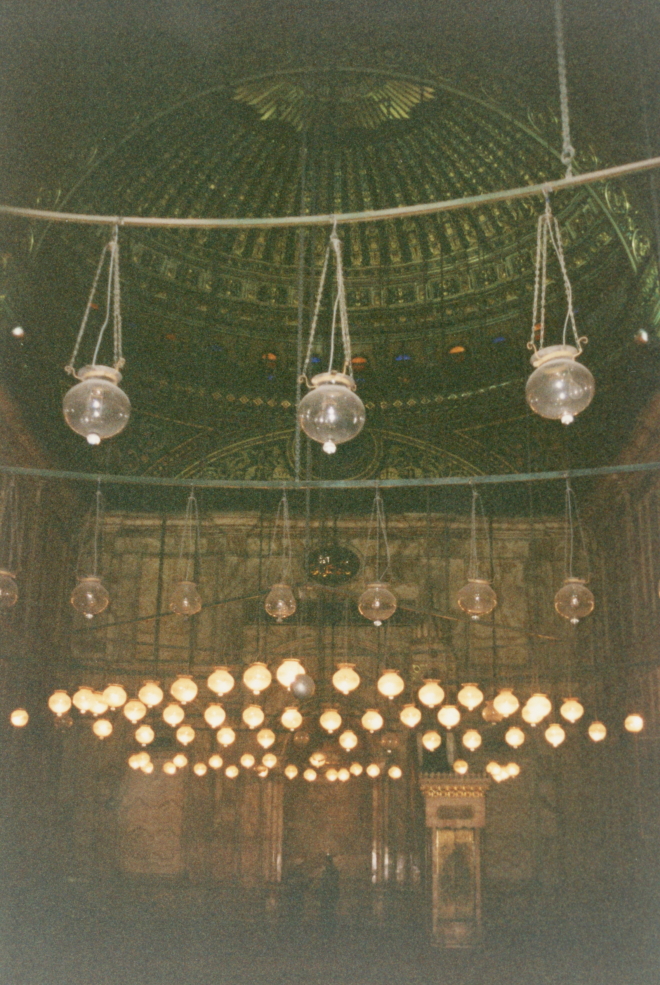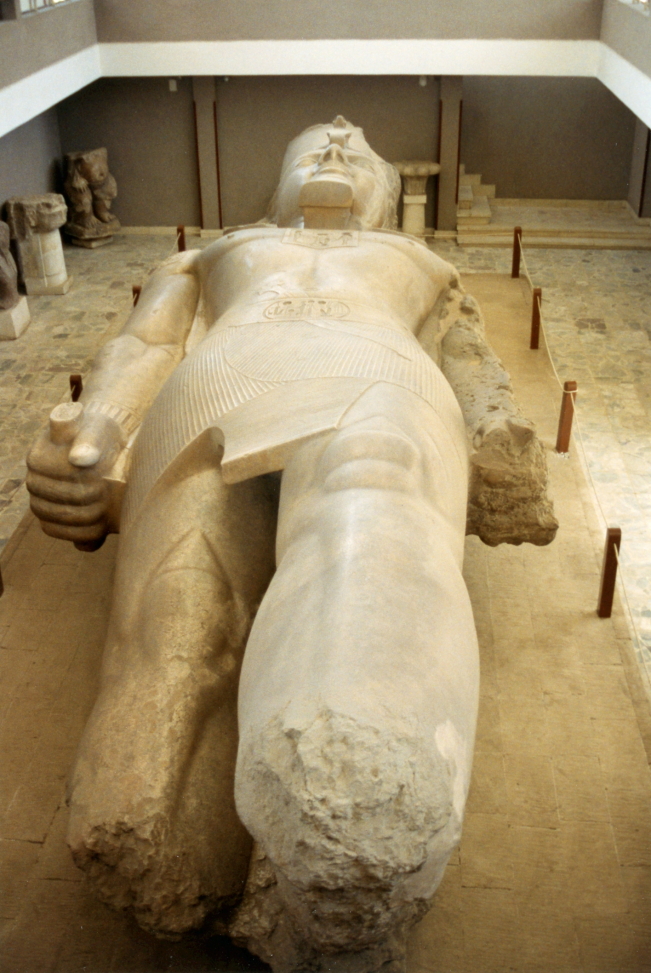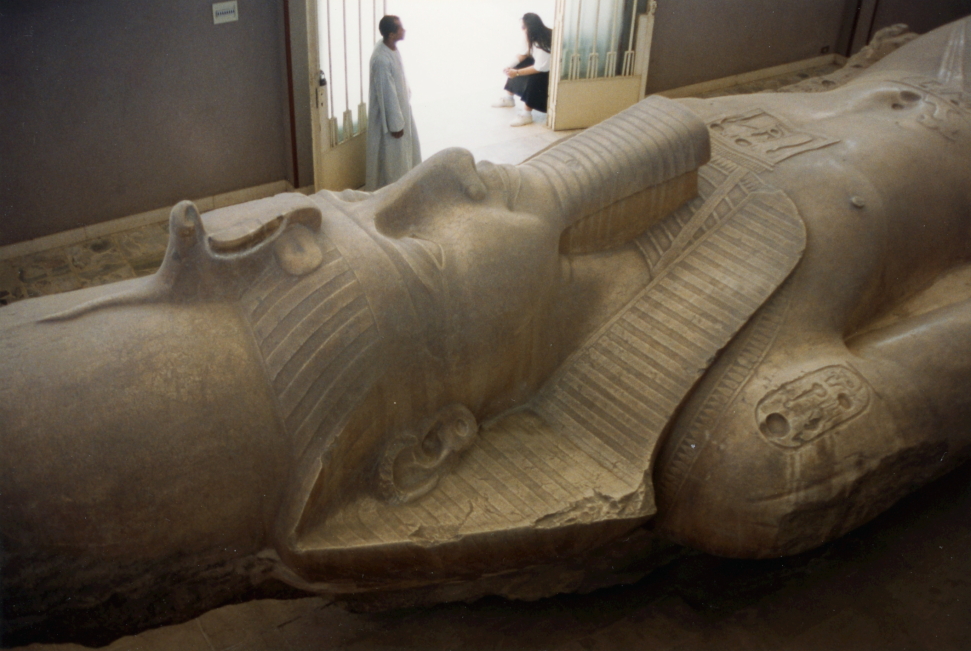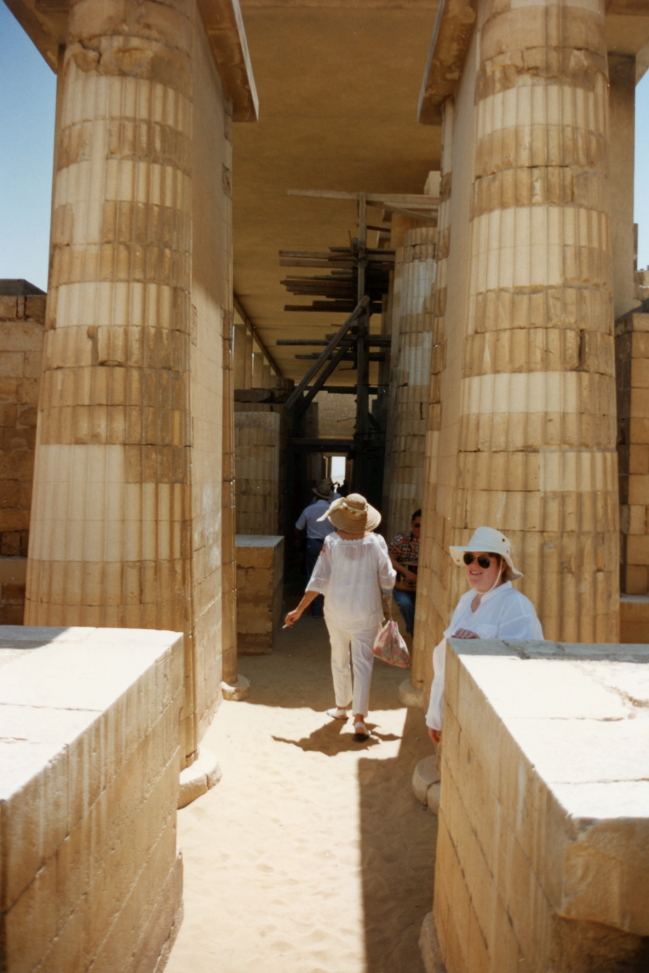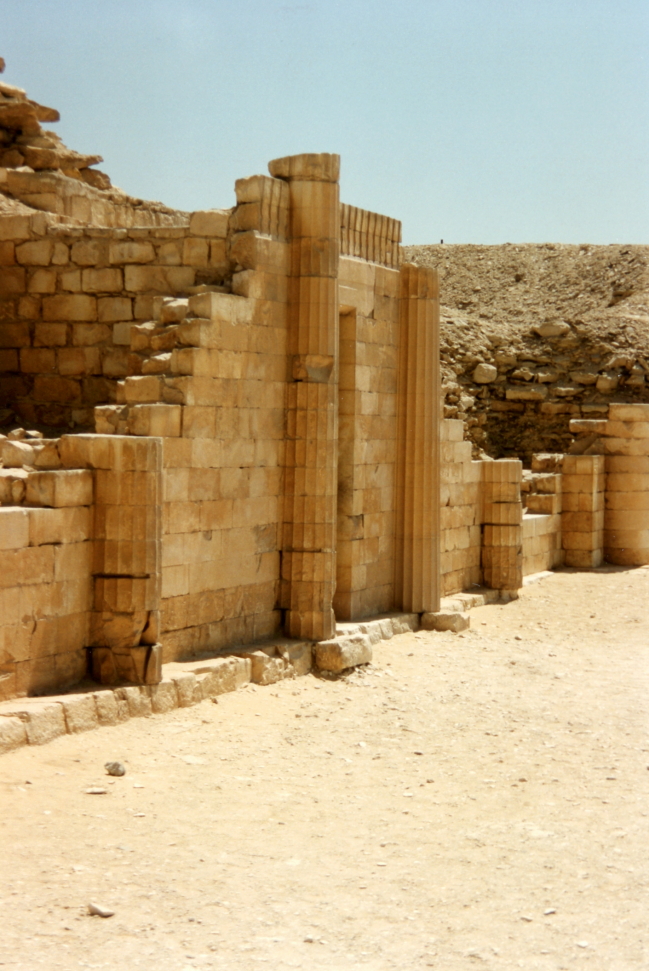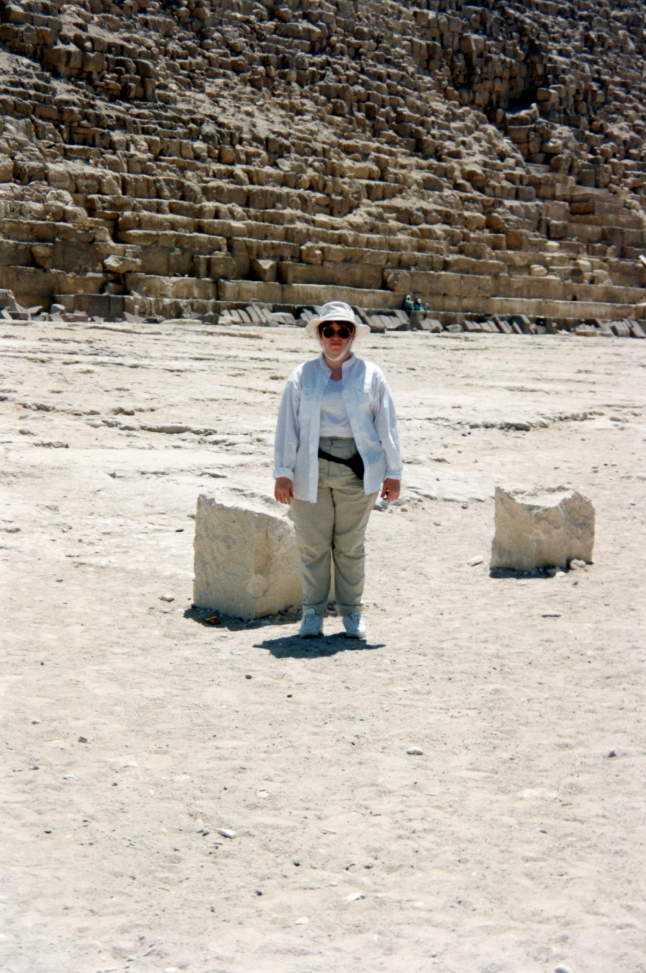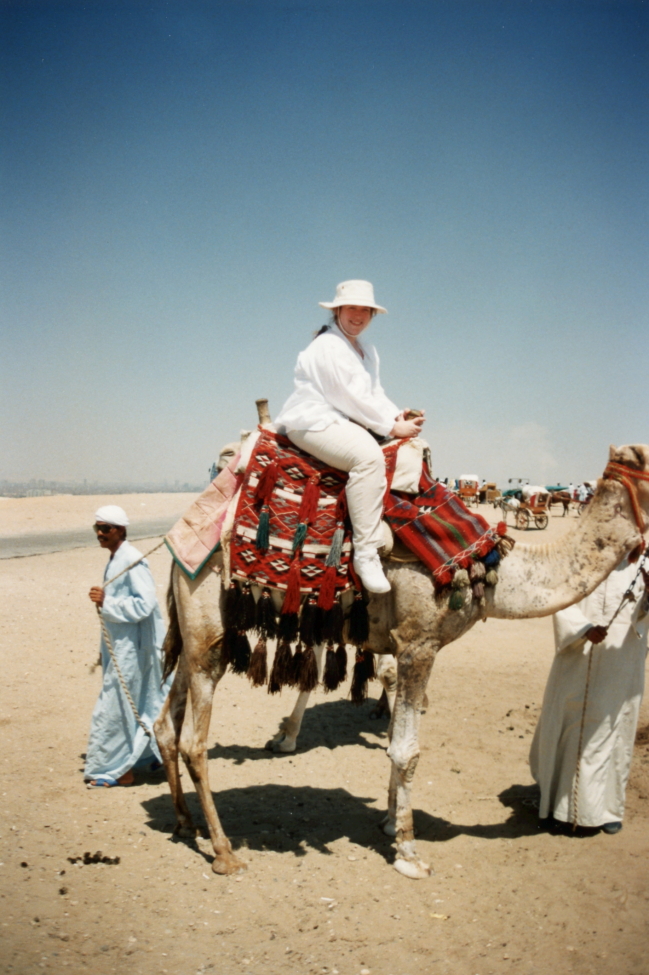Michelle writes:
Got up very early ~3:30. We got on a flight to Abu Simbel with a stop in Cairo [ed – should be Aswan, will correct here on out]. Sahar stayed on board until we got to Aswan. In Abu Simbel, we got on buses to get to the temples. There were two temples: Temple of Ramses II and the Temple of Queen Nefertari. When we got there Brian & I bought tickets. Our guide said he would meet us in front of the temple. We walked around the mountain. You could see Lake Nasser. The water was very pretty. As you came around the road, you suddenly came upon the temples. They were truly amazing, imposing, etc.
The first temple was Ramses II. He is in the mummy room at the Egyptian Museum. There are 4 giant figures. One was damaged in an earthquake and the face had fallen off. All the statues were of Ramses. Around his feet, and between his legs were statues representing his family. These are truly amazing temples when you consider that all were moved here when the Aswan Dam was built. Man made mountains were built to support the statues. There are 3 halls in the Ramses Temple. The first one was for the public. It also had huge statues of Ramses posed like Osiris with his arms crossed. On the walls, from ceiling to the floor were pictures. Many were of the gods & Ramses praying to them. Sahar said that they would build ramps to do the pictures at the top. The next room was for the priests. There were decorated store rooms leading off of this hall. The next hall had 4 statues of gods. The sun came into this room 2 a year. On Ramses birthday & his coronation. Since they moved it, it only shines one day later then before. The sun never touches the god representing death. In the Nefertari temple there were only 2 halls. The first was decorated like the Ramses one. The second had 1 niche with a statue which had been damaged. When we left the site we walked thru the mountain where the statues were. It is huge and hollow inside. Then we got on the plane & went to Aswan. In Aswan we got on the boat. 6 other tourist met us there. 4 are from Minnesota & 2 are from Richmond Va. After lunch ~3:00, we went on a felucca ride. A felucca is a type of Egyptian sailboat. It was very tranquil riding on the Nile. Sahar said that there were no crocodiles in this part of the Nile. Sahar pointed out sides along the way. There was graffiti from ancient times. Elephantine Island had a Club Med, and is a famous old site. We saw the Hotel Cataract where Agatha Christie wrote Death on the Nile. We rode the feluccas over to the Aga Khans Mausoleum. It was way up on the hill. We climbed up. Inside was all marble. The view from the top was beautiful. We rode the feluccas back. Brian is not feeling well. We met with Sahar at 7:30. There she gave us details about the rest of the trip. She will handle tipping for the rest of the excursions. At one we will go by carriages. Then we had dinner. Shishkebabs.
Brian writes:
Woke up at 3:30am (ugh!), Michelle at at 4:00am while I checked over our room. She left her night gown on the bed!!! I got a small bite of food, we left at 4:30am for airport with Mohammed. Streets were almost deserted, it was nice. Passed street with flags of lots of Islamic countries, made it to airport. Met Sahar’s husband, I’m much taller, contrary to what she says. Got a 6:00am flight to Aswan. No leg room, annoying Japanese which in front trying for many moments to back her seat up on top of my knees, unsuccessfully of course. Michelle puts a stop to that! At Aswan, Sahar gets off, we go on to Abu Simbel on same Egypt Air flight. Same stupid [ed – people] in front of me. Had orange juice & some weird half vanilla ([ed – illegible]) half chocolate pound cake. Terrain below us marvelous — all sorts of desert mountains, canyons. Occasionally see a dark black road pierce the desert in a stark line or the beautiful blue-green waters of Lake Nasser, created by the waters behind the High Dam at Aswan. Amazingly stark & beautiful. Land at Abu Simbel — small airport. Leave camera bag, Brenden bag in a nice, A/C room.

Lake Nasser, Upper Egypt

Lake Nasser, created by damming the Nile at Aswan
Go by Egypt Air bus through Abu Simbel (quaint village with sprinkler-bred trees — it only rains once every five years or so) to the ruins. As expected, a slew of Bazaar shops in front of entrance gate. Once inside, meet our guide. Walk around and down back of prefabricated hill to front of Abu Simbel. BEAUTIFUL! with Lake Nasser behind and Abu Simbel in front, we were in heaven. A smaller temple was to the right in its own prefab. hill.

Entrance to Abu Simbel on the shore of Lake Nasser

Temple of Nefertari, next to Ramses II’s temple

One of four Ramses II Colossi that sit in front of Abu Simbel
The temple was built by New Kingdom Pharaoh Ramses II. It originally stood 60m below, but was saved by UNESCO from the rising waters of Lake Nasser. They cut it into blocks, moved it, reassembled, then built a mountain for it.
The temple’s front has four statues of Ramses II, 2 on each side. His family in between and beside him. Other, various statues are about, including dancing baboons on the top, b/c they were thought to worship the sun god (b/c of [ed- illegible]) their excited cries in the morning. Each statue, 65 ft. high wore a different crown [ed – diagram of the front of the temple].

Two more Colossi

Remains of the Colossi that was heavily damaged in an earthquake

Statues of hawks at Abu Simbel
The second statue from the left has cracked (in an earthquake in ancient times) and the chest on up toppled on the ground. Go in entry way to Hopostyle (sp?) hall, where there are eight (?) or so statues of Ramses II as Osiris. You see, the whole purpose of Abu Simbel was for Ramses II to say he is a god. Osiris was the most popular god, so Osiris [ed – I think I meant Ramses II] represented himself as Osiris with eight pillars of him with hands folded on chest and dark painted eyes [ed – picture of a right eye]. This hall, the Hopostyle hall, was for the public, as they could not go into the other two prayer rooms [ed – diagram of a hall showing the positions of the eight statues, four on each side of the entry hallway]. On the walls, finally saw engraving of Ramses II on his chariot during the battle of Kadesh [ed – picture of the Pharaoh on the chariot]. Though historically a draw, with neither side wishing to fight and ending the war with the first recorded peace treaty (and Ramses marrying daughter of other king), Ramses wished to depict this as a great victory for him. It was a cool figure because the horses leap, Pharaoh’s arms, etc. were repeated a couple of times to give a blurring, motion sensation. NEAT! Went to the next hall, had King same size of gods, because he is trying to be like a god. From the first hall, from which the common people prayed, were many cool storerooms. These storerooms were eerily lit and stretched off the main hall [ed – diagram of storerooms going off of main hall].
Finally, saw the sanctuary, or “Holy of Holies,” where only the high priest (who wears a leopard skin) and pharaoh can go. It had 4 seated statues. One of Horus [ed – I wrote “Amon-ke, Hekaton-ke” above this, no idea why — hope it doesn’t summon a mummy!], Hathor, Ramses, and lastly, on the far left Osiris [ed – though I note the “yellow book says Ptah”]. In the old location, on February and October 21st, the Pharaoh’s Birthday & Coronation Day, the sun during sunrise shone all the way down 100’s of feet of halls to illuminate the right three statues — the only statue unilluminated was Osiris, god of the Underworld! In the new location, the date is the 22nd of Oct. and Feb. Extraordinary engineering feat!

Pharaoh Ramses II killing his enemies

Four statues in the inner chapel of the Temple of Ramses II at Abu Simbel

Pharaoh Ramses II in his war chariot
Next, went outdoors and saw his wife’s, Nefertari’s, tomb. It had four statues of her in front [ed – picture showing the front]. Inside, lots of references to Hathor, the Earth goddess. Much smaller, only two rooms.

Side of a statue at Abu Simbel

Ramses II Colossi at Abu Simbel

Entrance to the Temple of Ramses II seen from near the entrance to the Temple of Nefertari

Entrance to the Temple of Nefertari at Abu Simbel

Statue of Ramses II from within the Temple of Nefertari
Finally, went through prefab. mountain. It was spectacular! Huge, hollow, concrete, with steel stairs all over. Could see the temple outlines cased in concrete. It’s funny, while in the temple you never know the difference! 11:00 = Back to plane, arrive in Aswan at ~12:00pm. Get on a bus, goes through Aswan’s west bank suburbs — lots of sand. Crossed the old British dam (1898 – 1902) over the Nile. Went down into Aswan, boarded boat, MS Queen of Sheba. Got room 313, our luck! It is a nice room, with a bath, entry, bedroom, and a sitting area. It has, unfortunately, two single beds instead of a double bed. Had lunch 12:30pm, then releaxed (slept) until 3pm. I was not feeling that well. At 3pm, went down to the docks to get a felucca ride, all 15 of us. You see, we picked up 4 from Minnesota — Mike, Sheila, Dan, and ?. In addition, 2 from Richmond, Va., but really transplanted New Yorkers — Jerry and ?. With the original nine — Michelle and I, Sharon, Mr. Bob and Pat Hart, [ed – illegible] and Patsy, and Rose and Fred, makes 15. The felucca was marvelous [ed – crude diagram of a felucca showing rudder, covered area, mast, and keel]. Staffed by Nubians.

Boat on the Nile River at Aswan
Go by felucca past the Old Cataract Hotel, where Agatha Christie wrote Death on the Nile. Also saw some spectacular Pharaonic graffiti made by quarry workers in ancient times. Saw Elaphantine Isle, with its Nubian villages and ruins from ancient (particularly Ptolemaic to Roman) times. This was the town of Sylene (sp?), where Eratosthenes used the shadows (or lack thereof) in the wells here and in Alexandria to calculate the circumference of the Earth. Landed at a small bazaar right on the west bank of the river nestled among vegetation. Had twisting streets of mud, shops on all sides. Dogs laying about, with flies. Weave through bazaar, start up to Agha Khan Mausoleum. Spectacular views of city, sand hills, fertile valley, river, and islands. Can see people with camels. Long climb up (~15 minutes), no shade. Pass winter residence of Aga Khan. Aga Khan died in 1950’s, leader of Pakistan. 42nd shiek of Ismaili Muslim sect. Got his weight in gold every year for birthday. His son, Ali Khan, married Rita Haywood and gambled all the wealth away. Mausoleum marble inside, beautiful, take off shoes inside. Guard wants baksheesh, but not supposed to ask for it! Leave, return to boat by felucca. Rest, eat dinner shish-kabob. Sleep.

Felucca on the Nile River

Nile River scenery from the felucca

Ancient graffiti

Nile River bank from the felucca

The Old Cataract Hotel, where Agatha Christie wrote _Death on the Nile_

Reeds on the Nile River

The Nile at Aswan
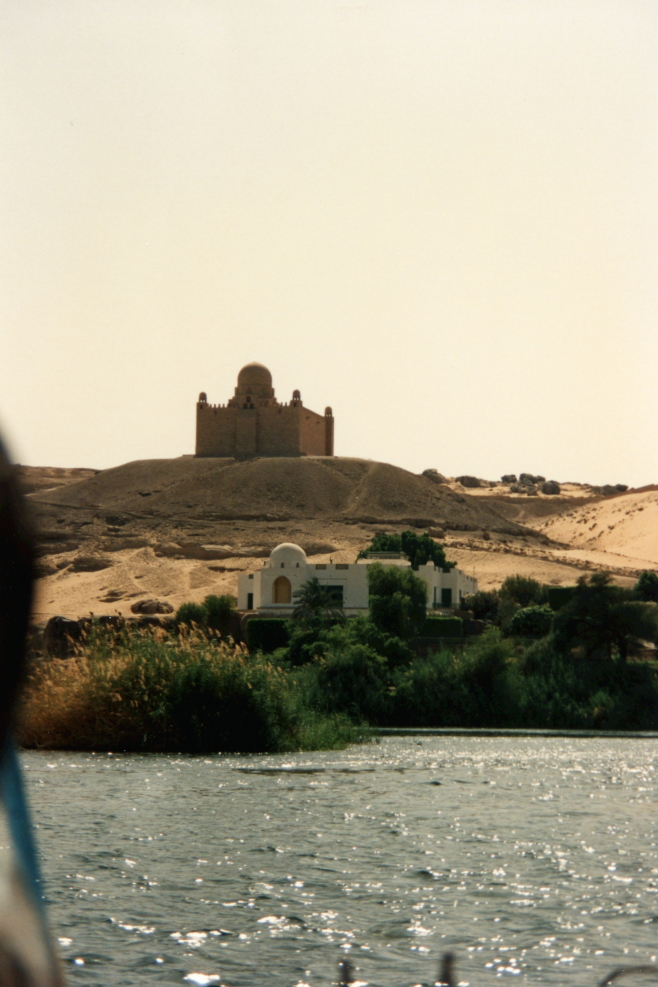
Mausoleum of Aga Khan from the Nile River

Another felucca sailing on the Nile

View of the Nile from the Mausoleum of Aga Khan

Another view of the Nile from Aga Khan

Building below Aga Khan

Yet another view of the Nile

The Nile near Aswan has many islands
P.S. The felucca fast became my favorite way to travel — it is so peaceful on the river, only the pitter-patter of waves and a very cool breeze snapping the sails [ed – crude drawing of a felucca]!

A very tired tourist gets well earned rest!




































